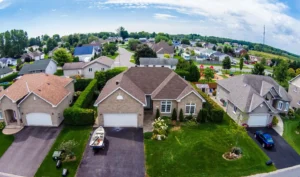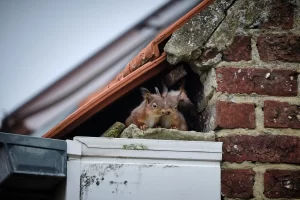Omaha homeowners need to keep an eye on their roofing systems. Multiple types of roof damage are common in Omaha and can have an impact on the condition of your home. When roof damage is left alone, it can quickly become worse and require major repairs. So, keep in mind that repairing Omaha roof damage as soon as possible will benefit the longevity of your roof.
Below, we’ll discuss the most common types of roof damage in Omaha. These types of damage may occur over the course of your roof’s lifespan and should be taken care of promptly.
Wind Damage
Here in Omaha, high winds are common throughout the year. Especially for shingle roofing systems, high winds can lead to significant damage. Wind damage typically occurs at wind speeds of 45 miles per hour and higher. The main types of roof damage that can result from high winds include:
- Curled roof edges
The edges of your roof are the most susceptible to wind damage. High winds can uplift the edges of a roof and start to peel back the shingles. When this type of damage occurs, your shingles won’t be as effective at keeping water and moisture out of your roof’s underlying structure. Over time, deterioration and water damage can result.
- Missing shingles
Extremely high winds may have the power to not just peel back, but fully remove shingles from your roof. You may notice shingles around the perimeter of your house or in your yard. With missing shingles, your roofing system is far more likely to incur damage, especially if a storm hits. This makes it crucial to have missing shingles replaced promptly by your Omaha roof repair specialists.
- Missing shingle granules
If you have an asphalt shingle roof, you likely know that the topmost layer of each shingle consists of small granules. These granules are important to the durability of the shingles and help protect your roof against multiple weather conditions. Unfortunately, high winds can blow granules off of your shingles, diminishing the strength of your roof. After high winds pass over your home, you may notice that shingle granules have built up in your gutter system.
Tree Damage
Trees can enhance the appearance of your property and beautify your lawn. But, unfortunately, trees can also damage your roof if they’re not well maintained.
Overhanging Branches
Branches from a nearby tree hanging over your roof can lead to damage. If the branches scratch against your roof in a breeze, the outer layer of your roofing material could be compromised. This is especially true for asphalt shingles, which have granules that can be scratched off by overhanging branches.
Broken Branches
If overhanging branches break, whether due to the force of high winds, the weight of fallen snow, or just old age, serious roof damage can occur. The branch may dent or even puncture the surface of your roof. If the puncture extends down through the layers of your roof, it may create a leak. A roof leak is a major issue that can lead to water damage throughout your home.
To avoid damage from overhanging and broken branches, be sure to have tree branches trimmed back regularly. This will ensure that the branches are out of reach of your roof.

Hail Damage
The Omaha area often experiences severe hailstorms. Hailstorms pose a big risk to your roof and may cause multiple types of damage, including:
Missing Shingles
In severe hailstorms, shingles may be pulled off of your roof. As aforementioned, missing shingles heighten your roof’s risk for damage.
Bruised Shingles
When sizable hailstones hit an asphalt roof, bruising can result. When an asphalt shingle is bruised, it means that it has a visible indentation where the hailstone hit. Bruising damages the outer protective layer of asphalt shingles.

Dents and Punctures
Hailstorms may cause dents and/or punctures in your roofing system. A dented or punctured roof requires immediate attention to repair the damage. Left unrepaired, roof hail damage can escalate into an irreversible roofing issue.
No one wants to have to replace their roofing system early. To ensure that your Omaha roofing system will last for as long as possible, have any damage checked out by your roofing specialists immediately.





